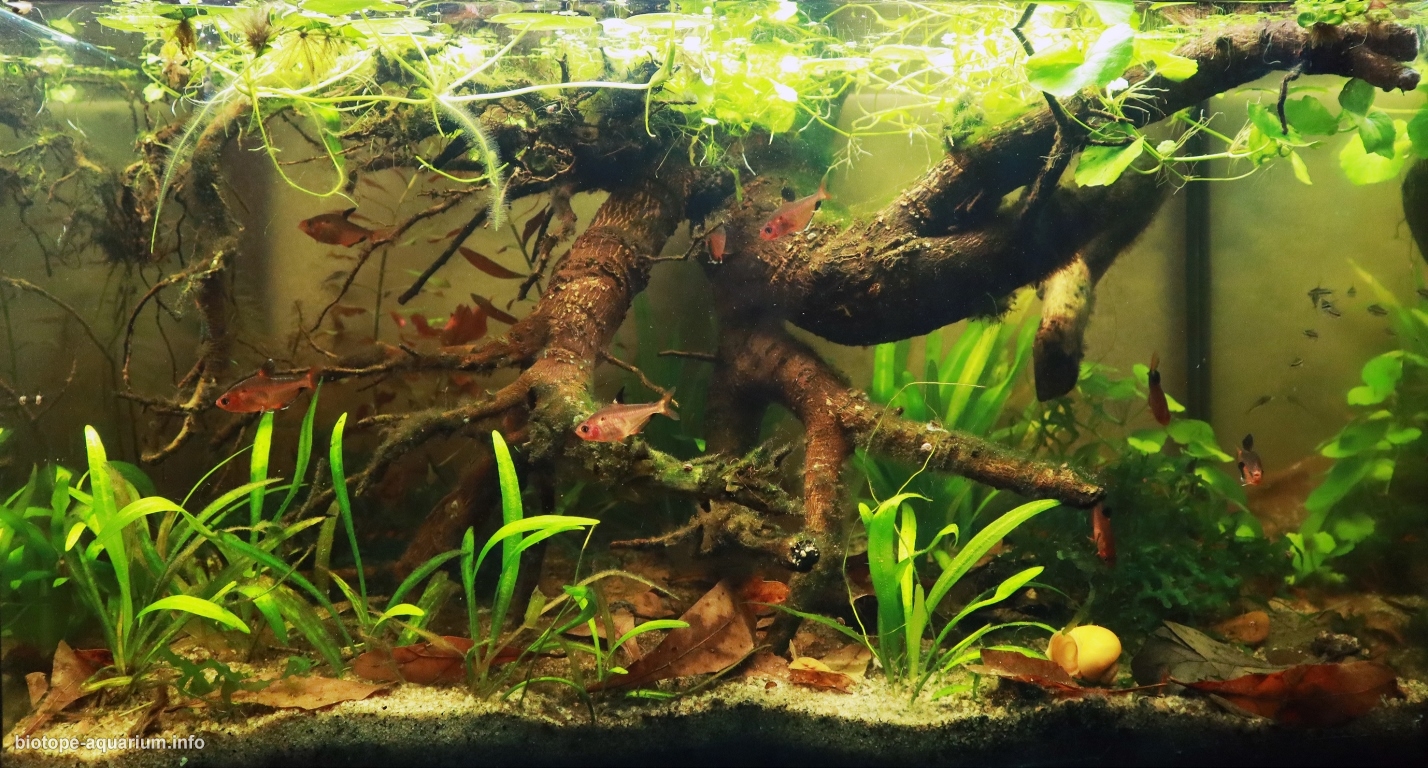Salobra River in the Pantanal wetlands of Mato Grosso do Sul, Brazil
_th place in Biotope Aquarium Design Contest 2020

Volume: 61 liters
Dimensions: 50x35x35 cm
List of fishes: Hyphessobrycon eques, Corydoras pygmaeus, Apistogramma borellii, Pomacea bridgesii
List of plants: Echinodorus quadricostatus, Ludwigia sp., Hydrocotyle leucocephala, Myriophyllum sp.
Description of decorations: Soil from of sand 0.5-2 mm The soil is covered with ketapang leaves and fruit tree leaves. Driftwood and roots in shape and color similar to found in the natural biotope.
Description of equipment: Internal filter, Aquael FAN 1 Plus, Lamp SunSun HDD-600B, 2x24W T5 (Osram Cool White); Heater with thermostat, Atman AT 138, 75W
Water parameters: temperature 24-25° С
color: slightly tea color
KH 7,5
PН: 7
Additional info: Snooty, funny, restless – this is about a flock of Hyphessobrycon eques, it is they who play the main role in this aquarium. To create a biotope aquarium for Hyphessobrycon eques I was inspired by the video https://youtu.be/YI1LwplUx08 – tree roots, a variety of plants and among them schools of fish! I had to limit myself to only two schools of fish, since the aquarium has a small volume. The Hyphessobrycon eques company consisted of Corydoras pygmaeus, a pair of Apistogramma borellii and Pomacea bridgesii. A beautiful root, thickets along the back wall of the aquarium, floating plants and leaf litter, in my opinion, were able to convey the atmosphere of a natural reservoir.
INFORMATION ABOUT BIOTOPE:
Description of the area surrounding the biotope: The Pantanal is an area in Brazil that covers the largest tropical wetlands in the world. It is located in the state of Mato Grosso do Sul, Brazil, and extends into parts of Mato Grosso, Bolivia and Paraguay. It covers an area of 195,000 to 140,000 square kilometers. The Pantanal is home to over 400 species of fish and thousands of invertebrates. In the fish population, about 80% of individuals.
The Salobra River is located in the wetlands of the southern Pantanal and during the rainy season, when river banks and surrounding flooded meadows and forests become flooded, it provides habitat and food for many of the 330 fish species found in the Pantanal.
Description of the underwater landscape of the biotope: Pantanal, clear water biotope, during a rainy season. Plants with small leaves, growing densely, along with pieces of driftwood and roots of nearby tree provides good shelter for small fishes like Apistogramma sp. Nannostomus sp. Corydoras sp. Water is full of small crustaceans and insect larvae, giving an excellent food source and encourages fish to spawn. Quite low water level near the banks (only about 50cm) of the pond keeps the large predators away. Detritus, algae and protozoa that occurs in leave litter, on the wood and plants are a good source of food for fry. Underwater live is showing its beauty everywhere. In the places where sunlight reaches the water undisturbed by trees, and uncovered by leaves, aquatic vegetation occurs in its greatness.
Description of the parameters of the habitat: Water parameters varies depends on time of the year, but water is almost clear has a light tea shade (small amount of tannins occur in the areas where trees grow), soft and slightly acidic with parameters: pH 6.0-6.8; hardness 1 dH; electrical conductivity 5-20 µS/cm (to 100µS/cm in the seasonally almost drying lakes and oxbows), temperature 22-28°C
List of fishes and invertebrates occurring in the nature biotope: Hyphessobrycon sp., Aphyocharax sp., Hemigrammus sp., Gymnocorymbus sp., Corydoras sp., Otocinclus sp., Apistogramma sp., Pomacea bridgesii and many more, commonly in high numbers.
List of plants found in the nature biotope: Helanthium sp., Echinodorus sp. (many species), Ludwigia sp., Cabomba furcata, Myriophyllum sp., Hydrocotyle leucocephala, Egeria najas, Salvinia auriculata, Eichhornia crassipes, Eichhornia azurea, and many more depends of water mark during high and low water levels.
Threats to the ecology: Pantanal is the marvelous, but unfortunately slowly dying, place on Earth. It’s one of two greatest wetlands on the planet. Once
extremely rich on terrestrial and aquatic flora and fauna. Cattle farms, soya plantations, trees burning or cutting… Many of rare and endemic species are trying to survive in the small wild areas that stays untouched by human. The beauty of this areas is in danger, so people must see and try to preserve them for future.
The Salobra River is the only river in the state where fishing is prohibited, meaning that the fish community is large and diverse, which in turn sustains many other animals here, including large numbers of birds, giant otters, and countless other creatures. The river is only protected due to the efforts of the Refugio da Ilha Ecolodge, who were able to successfully lobby the regional government. The result is a rich ecosystem that attracts visitors from around the world, whether to see birds, otters, anacondas, caiman, jaguars or enter the water with a mask and snorkel to discover the incredible life beneath the surface.
Sources of information:
https://en.wikipedia.org/wiki/
https://www.fishbase.in/
https://www.youtube.com/watch?
https://www.scielo.br/scielo.
https://bdj.pensoft.net/
https://www.scielo.br/scielo.
http://www.eventus.com.br/
